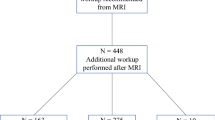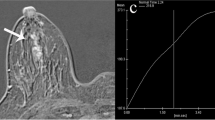Abstract
Purpose
To assess the utility of second-look ultrasound (US) for identifying and characterising incidental enhancing lesions detected by breast magnetic resonance imaging (MRI).
Materials and methods
From among 655 consecutive breast MRI studies, 62 lesions (MRI visible, nonpalpable, occult at first-look US and mammography) were recommended for second-look US. MRI enhancement of lesions was mass-like in 59 cases (95%) and non-mass-like in three (5%). Forty-two lesions (68%) were ≤10 mm; only three lesions (5%) were >20 mm. Of all lesions, the Breast Imaging Reporting and Data System (BI-RADS) MRI category was highly suggestive of malignancy in six cases (10%), suspicious abnormality in 33 (53%) and probably benign in 23 (37%). The correlation between MRI lesion appearance, lesion size, histopathology findings and detection rate at second-look US were analysed. The reference standard was histopathology and/or follow-up (range 18–24 months). Statistical analysis was performed with the Fisher exact test.
Results
Second-look US identified 44 out of 62 (71%) lesions depicted at MRI. The detection rate at second-look US was higher for mass-like MRI lesions (75%) than nonmass-like lesions (0%), for lesion size >10mm (90%) and for BI-RADS 4 lesions (88%). Second-look US-guided biopsy detected 12 out of 17 (71%) malignant lesions. There was no correlation between the likelihood of carcinoma and the presence of a sonographic correlate.
Conclusions
Second-look US is a reliable problemsolving tool in identifying and characterising most incidental MRI findings. It contributes to accurately selecting the cases in which MRI-guided biopsy is required.
Riassunto
Obiettivo
Lo scopo del lavoro è stato verificare l’utilità del second look ecografico nella identificazione e nella tipizzazione delle lesioni incidentali alla risonanza magnetica (RM) mammaria.
Materiali e metodi
È stata effettuata un’analisi retrospettiva di 62 lesioni identificate incidentalmente dalla RM, non palpabili e occulte alla mammografia ed ecografia espletate prima della RM. L’impregnazione delle lesioni era tipo massa in 59 casi (95%) e non massa in 3 casi (5%). Quarantadue lesioni (68%) erano ≤10 mm; solo 3 lesioni (5%) erano >20 mm. Il grado di sospetto RM era alla classificazione breast imaging reporting and data system (BI-RADS) 5 in 6 casi (10%), BI-RADS 4 in 33 casi (53%), BI-RADS 3 in 23 casi (37%). Le lesioni RM con corrispettivo reperto al second look ecografico sono state analizzate riguardo: aspetto RM, dimensioni, sospetto radiologico, diagnosi istologica. Il gold standard è stato l’esame patologico o il follow-up clinico e strumentale a 24 mesi. I risultati sono stati analizzati con il test statistico di Fisher (significatività: p<0,05).
Risultati
Il second look ecografico ha identificato 44/62 (71%) lesioni incidentali alla RM mammaria. Il numero di lesioni identificate con il second-look è stato superiore in caso di impregnazione di tipo massa (75%), lesioni con dimensioni >10 mm (90%) e con BI-RADS 4 (88%). Dodici/44 (27%) lesioni identificate dal second look ecografico erano maligne e 5/18 (27%) lesioni prive di traduzione ecografica erano maligne. Il prelievo guidato dal second look ecografico ha caratterizato 12/17 (71%) lesioni maligne.
Conclusioni
Il second look ecografico è una valida metodica nel management delle lesioni identificate incidentalmente dalla RM mammaria in quanto consente l’identificazione e la caratterizzazione della maggioranza di esse e l’accurata selezione di quelle da avviare a procedure RM-guidate.
Similar content being viewed by others
References/Bibliografia
Bartella L, Liberman L, Morris EA et al (2006) Nonpalpable mammographically occult invasive breast cancers detected by MRI. AJR Am J Roentgenol 186:865–870
Liberman L (2004) Breast cancer screening with MRI — what are the data for patients at high risk? New Engl J Med 351:497–500
Robson ME, Offit K (2004) Breast MRI for women with hereditary cancer risk. J Am Med Assoc 292:1368–1370
Morris EA, Liberman L, Ballon DJ et al (2003) MRI of occult breast carcinoma in a high-risk population. AJR Am J Roentgenol 181:619–626
Girardi V, Carbognin G, Camera L et al (2010) Fischer’s score criteria correlating with histopathological prognostic factors in invasive breast cancer. Radiol Med, 115:421–433
Mann RM, Hoogeveen YL, Blickman JG et al (2008) MRI compared to conventional diagnostic work-up in the detection and evaluation of invasive lobular carcinoma of the breast: a review of existing literature. Breast Cancer Res Treat 107:1–14
Orel SG, Schnall MD (2001) MR imaging of the breast for the detection, diagnosis, and staging of breast cancer. Radiology 220:13–30
Sardanelli F, Giuseppetti GM, Canavese G, et al (2008) Indications for breast magnetic resonance imaging. Consensus document “Attualità in senologia”, Florence 2007. Radiol Med 113:1085–1095
Peters NH, Borel Rinkes IH, Zuithoff NP (2008) Meta-analysis of MR imaging in the diagnosis of breast lesions. Radiology 246:116–124
Teifke A, Lehr HA, Vomweg TW (2003) Outcome analysis and rational management of enhancing lesions incidentally detected on contrastenhanced MRI of the breast. AJR Am J Roentgenol 181:655–662
Brown J, Smith RC, Lee CH (2001) Incidental enhancing lesions found on MR imaging of the breast. AJR Am J Roentgenol 176:1249–1254
Lagios MD (1977) Multicentricity of breast carcinoma demonstrated by routine correlated serial subgross and radiographic examination. Cancer 40:1726–1734
Holland R, Veling SH, Mravunac M et al (1985) Histologic multifocality of Tis, T1-2 breast carcinomas: Implications for clinical trials of breastconserving surgery. Cancer 56:979–990
Vaidya JS, Vyas JJ, Chinoy RF et al (1996) Multicentricity of breast cancer: Whole-organ analysis and clinical implications. Br J Cancer 74:820–824
Rosen PP, Fracchia AA, Urban JA et al (1975) ’Residual’ mammary carcinoma following simulated partial mastectomy. Cancer 35:739–747
Houssami N, Ciatto S, Macaskill et al (2008) Accuracy and surgical impact of magnetic resonance imaging in breast cancer staging: systematic review and meta-analysis in detection of multifocal and multicentric cancer. J Clin Oncol 26:3248–3258
Braun M, Pölcher M, Schrading S et al (2008) Influence of preoperative MRI on the surgical management of patients with operable breast cancer. Breast Cancer Res Treat 111:179–187
American College of Radiology (ACR) (2003) Breast Imaging Reporting and Data System Atlas (BI-RADS® Atlas). American College of Radiology, Reston
Morris EA (2006) Breast MR imaging lexicon updated. Magn Reson Imaging Clin N Am 14:293–303
Heywang-Köbrunner SH, Sinnatamby R, Lebeau A et al (2008) Consensus Group. Interdisciplinary consensus on the uses and technique of MR-guided vacuum-assisted breast biopsy (VAB): results of a European consensus meeting. Eur J Radiol 72:289–294
LaTrenta LR, Menell JH, Morris EA et al (2003) Breast lesions detected with MR imaging: utility and histopathologic importance of identification with US. Radiology 227:856–861
Beran L, Liang W, Nims T et al (2005) Correlation of targeted ultrasound with magnetic resonance imaging abnormalities of the breast. Am J Surg 190:592–594
Sim LS, Hendriks JH, Bult P et al (2005) US correlation for MRI-detected breast lesions in women with familial risk of breast cancer. Clin Radiol 60:801–806
Wiratkapun C, Duke D, Nordmann AS et al (2008) Indeterminate or suspicious breast lesions detected initially with MR imaging: value of MRI-directed breast ultrasound. Acad Radiol 15:618–625
Linda A, Zuiani C, Londero V et al (2008) Outcome of initially only magnetic resonance mammographydetected findings with and without correlate at second-look sonography: distribution according to patient history of breast cancer and lesion size. Breast 17:51–57
DeMartini WB, Eby PR, Peacock S, Lehman CD (2009) Utility of targeted sonography for breast lesions that were suspicious on MRI. AJR Am J Roentgenol 192:1128–1134
Author information
Authors and Affiliations
Corresponding author
Rights and permissions
About this article
Cite this article
Carbognin, G., Girardi, V., Calciolari, C. et al. Utility of second-look ultrasound in the management of incidental enhancing lesions detected by breast MR imaging. Radiol med 115, 1234–1245 (2010). https://doi.org/10.1007/s11547-010-0561-9
Received:
Accepted:
Published:
Issue Date:
DOI: https://doi.org/10.1007/s11547-010-0561-9




